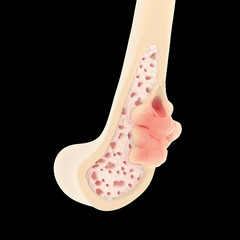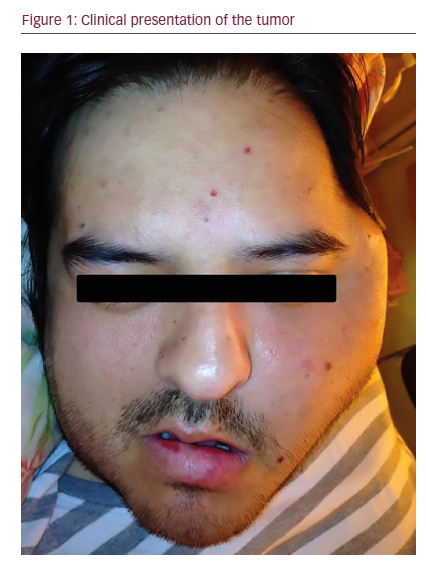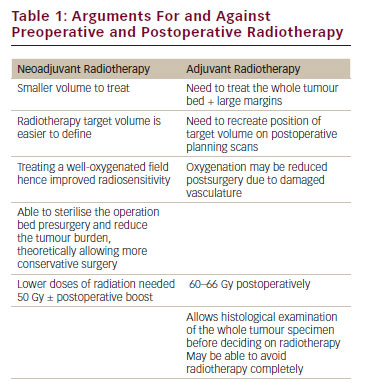Image-guided RF thermal ablation (RFTA) is a branch of interventional oncology that uses direct application of RF-generated heat to coagulate and destroy tumour tissue.6 The term covers coagulation induction from all electromagnetic energy sources with frequencies less than 30MHz; most currently available devices function in the 375–500kHz range.7 It is the most commonly used technology for thermal ablation in bone, liver, kidney, lung, heart, breast, lymph nodes, nerve ganglia and soft tissue. This article addresses the use of RFTA in the treatment of bone tumours and tumour-like lesions.
Image Guidance
Image guidance is critical to the success of this therapy. Among crosssectional techniques (computed tomography [CT], US, magnetic resonance imaging [MRI]), CT is considered the most useful to treat bone tumours because it is widely available, provides faster imaging acquisition and allows better anatomical resolution of deeper-seated or smaller tumours, avoiding damage to other surrounding tissues and structures. Image guidance contributes at every stage:
- pre-procedure: assessment of the volume and configuration of the tumour for selecting the appropriate size of active electrode tip and for planning a safe approach to the lesion that avoids sensitive neurovascular structures;
- localisation of the non-insulated active tip of the electrode; and
- post-procedure: follow-up of patients, preferentially by means of MRI, after bone treatment to minimise the radiation dose.
Instrumentation
RFA is an electrosurgical technique; the RF device comprises an electric generator connected to a probe or electrode and grounding pads (see Figure 1). An electrical circuit is formed in the patient by placing the electrode tip at the bone lesion and the grounding pads at the thighs. The generator produces an alternating current at the tip of the active electrode in the tumour; the current exits through grounding pads placed on the skin and returns to the generator. The alternating current of high-frequency radio waves passes from the non-insulated electrode tip to the tissue, where their energy is dissipated as heat, leading to cell death and coagulation necrosis. Heat is produced by resistive forces that generate ionic and molecular agitation in the tissues surrounding the electrode during attempts by the radio waves to return to the ground pads.8 RF energy is applied with a metal electrode (14–21G) covered with insulating material except at the tip, with an active tip length of 1–3cm.
Many types of electrodes are available: monopolar, with a single electrode; bipolar, with two electrodes; cluster, with three or more closely spaced electrodes of <1cm; and umbrella or multitined expandable electrodes, with an array of multiple electrode tines that expand from a larger, centrally positioned needle cannula. With the bipolar system, active and return electrodes are placed in the tumour, and return surface grounding pads are not necessary. Heat is generated not only around the active electrode but also around the ground needle and in the region between the two closely spaced electrodes. This results in larger zones of coagulation necrosis and improved protection of surrounding tissues.9
Some electrodes are internally cooled by saline or water that flows in an internal lumen not in direct contact with patient tissues. Perfusion electrodes have small apertures at the active tip that allow fluids to be infused or injected into the tissue before, during or after the ablation procedure.6
The type of electrode and size of active tip influence the size and morphology of the induced tumour necrosis. A rod electrode is usually more appropriate in bone tumour treatment because it can be inserted through a drill hole; the distribution of heat around the monopolar electrode can be expected to follow a cylindrical contour with rounded edges. More heat generation is produced in tissues with lower resistance, and tissue resistivity is much higher in cortical than in marrow bone. Hence, cortical tissue is much more resistant to heating and has an insulating effect when intact, protecting surrounding soft tissues and cartilage.10
At our centre, we use a hammer, vertebroplasty needle (100cm, 13 or 10G) and biopsy trephine (150cm, 13 or 15G) to reach the bone tumour and open up an entry channel for the electrode (see Figure 1).
Procedure
The procedure can be performed under general anaesthesia or conscious sedation. Nerve blockage can be used when limbs are involved. After imaging the whole bone lesion, the optimal approach route is selected to the best site for obtaining complete treatment of the bone after the fewest possible ablation sessions. When the route must pass close to sensitive anatomical structures (blood vessels, nerves), the needle is carefully introduced in short steps followed by CT monitoring. An intramuscular needle is first inserted at the selected site to guide the entry of the thicker vertebroplasty needle. CT monitoring allows any deviations from the route to be corrected, and the needle is placed in the bone up to the edge of the tumour. A biopsy trephine is then introduced to obtain material for the pathology study, creating a channel for entry of the RF electrode. After the correct insertion of the electrode, and without displacing it, the guide cannula is withdrawn as far as possible to avoid it coming into contact with the active electrode tip, which could lead to the cannula being heated and burning the pathway and skin. Immediately afterwards (within 30–60 seconds), the power output is increased to 90°C and dry ablation is performed for six minutes. In large lesions, the vertebroplasty needle is moved to another selected site, and the procedure is repeated as often as necessary.
A typical RF treatment has an output reading of less than 10W and an impedance of less than 150Ω. Once the treatment is completed, the RF electrode is removed and a small dressing is applied to the skin.11
Bone Tumour Treatment by Radiofrequency Thermal Ablation
Therapeutic indications are classically divided between palliative, where the purpose of treatment is to provide symptomatic relief, and curative, where the purpose is complete tumour destruction.9 The approach to benign bone tumours, such as osteoid osteoma, is curative, while the treatment of malignant tumours or metastases is largely palliative. RFTA is used when it is considered to offer an advantage over conventional therapies. Image-guided RFTA is an interesting option in cancer patients with refractory pain that does not respond to conventional therapies. It reduces pain and improves the function and quality of life of patients with painful bone tumours. It has been used to treat benign bone tumours and tumour-like lesions as a single modality or as an adjunct to surgical therapy. CT tomography-guided RF or laser ablation is the gold standard procedure for most osteoid osteomas.12 RF or laser thermal ablation also offers an alternative palliative therapy for localised and painful osteolytic metastatic lesions.13 The reduction of pain that can be obtained improves the quality of life of patients with cancer, who often have multiple morbidities and a limited life expectancy. A multidisciplinary approach to the management of these patients is recommended to select the optimal treatment, including orthopaedic surgeons, neurosurgeons, medical and radiation oncologists and interventional radiologists.
Bone Tumours
Osteoid Osteoma
Osteoid osteoma is a painful benign osteoblastic bone tumour. It is composed of osteoblasts and an osteoid forming a small (usually <15mm) radiolucent nidus. The nidus is usually surrounded by an osteoblastic wall and periosteal reaction with increased neural and arterial supply. It is most frequently observed in the cortex of long bones in children and young adults. Osteoid osteoma, first described in 1935,14 is relatively common and accounts for around 10% of all benign bone tumours.15 Three distinct management options exist: surgery, percutaneous therapy and conservative medical treatment. Although cases of spontaneous regression have been reported,16 the prolonged presence of the tumour may lead to complications, including growth disturbances, scoliosis and osteoarthritis.17 Medical management used to be appropriate when the sole alternative was traditional surgical resection. However, RFTA, with its high success rates, low complication rates and short recovery period, can now be considered the treatment of choice for most osteoid osteomas located in the appendicular skeleton and pelvis (see Figure 2). The technical and clinical success of RFTA in osteoid osteomas was first reported by Rosenthal18 in 1992.
CT-guided RFTA of osteoid osteomas is indicated when a presumptive diagnosis is made based on history, clinical examination and CT. Pathological confirmation is not usually required for this treatment. TC99 scintigraphy also plays an important role in defining an active lesion.
Other Bone Tumours or Tumour-like Lesions
Other benign bone conditions are also suitable for RFTA treatment, including giant cell tumour, chondroblastoma, osteoblastoma, haemangioma, eosinophilic granuloma and enchondroma. Chondroblastoma is a benign cartilaginous tumour that mainly arises in the epiphysis of long bones (e.g. femur, humerus or tibia) in children and young adults. Surgical removal is often difficult and RFTA has been reported as an alternative curative therapy in these cases.19 Osteoblastoma is a rare, benign, bone-forming tumour that is histologically related to the more common osteoid osteoma. Almost 90% of patients are diagnosed before 30 years of age. Despite its benign nature, this tumour can exhibit aggressive behaviour and become larger than an osteoid osteoma (2cm). Recurrences are not uncommon after classic treatment by surgical excision or curettage.20 RFTA is a less invasive alternative and is performed in the same way as for osteoid osteomas, using electrodes with a longer active tip or a larger number of ablation sessions.21 There are fewer published reports on the treatment of other benign bone conditions, e.g. giant cell tumour, enchondroma, eosinophilic granuloma and bone haemangioma (see Figure 3). However, we have used RFTA to treat patients with these diagnoses at our centre, obtaining good pain control and detecting no growth in follow-up studies.
Metastases and Myeloma
Skeletal metastases are frequently observed in cancer patients. Although bone metastases can be produced by any cancer, they largely derive from breast, prostate, kidney, lung, pancreatic, colorectal, stomach, thyroid and ovarian tumours. The spine is the most commonly involved site, followed by the pelvis, hip, femurs, ribs and skull.22 Plasmocytoma and myeloma are haematological malignancies that cause skeletal destruction with osteolytic lesions and/or pathological fractures. Skeletal metastasis and haematological malignancies can cause substantial morbidity, including pain, pathological fractures, neurological deficits, anaemia and hypercalcaemia secondary to osteoclastic activity and immobilization. Pain is frequently located in regions subjected to constraint, e.g. the back, long bones or pelvis. These complications may be associated with decreased mobility and reduced performance status, affecting the quality of life of patients and leading to depression and anxiety.
At present, treatment of bone pain from metastasis remains palliative. Treatment options include localised (surgery or radiotherapy), systemic (chemotherapy, hormonal therapy, radiopharmaceuticals and bisphosphonates) and analgesic (opioids and non-steroidal antiinflammatory drugs) therapies.23,24 Surgery is usually reserved for the prevention and treatment of fractures and related complications, for the resolution of spinal cord compression and, sometimes, for the resection of an isolated metastasis.25 External beam radiation therapy is the current gold standard treatment for cancer patients with localised bone pain. Nevertheless, 20–30% of patients do not experience pain relief with this approach.13 Radiation treatment can also result in additional early bone loss due to inflammation, and limited weight-bearing should be recommended during radiation to prevent pathological fractures.
Considering that the life expectancy of most patients with bone metastases is limited and that around 12–20 weeks is usually required before maximum benefit is obtained from post-radiation therapy,23 the aim must be to provide the earliest possible pain relief.
Reports on the usefulness of chemotherapy to reduce the primary tumour mass and related lesions have ranged from 20 to 80% of patients. It has also been found to induce drug resistance and have toxic effects, e.g. myelosuppression, and to fail to relieve bone pain.26 Hormonal therapy is effective only in metastases from breast and prostate cancer. Radioisotope therapy has been proved effective in patients with multiple bone metastases, but is not considered a standard treatment for single metastases. In osteoblastic and mixed-type metastases, systemic radioisotope therapy with strontium-89, samarium-153, rhenium-186 or rhenium-188 appears to be a good alternative. These radioisotopes are β-emitters with a penetration of a few millimetres that accumulate in the surrounding hyperactive bone tissue and not in the cancer cells. Because of the accumulation in hyperactive bone, this technique is limited to osteoblastic and mixedtype metastases (e.g. prostate and breast cancer),27 except for patients with osteolytic metastases from thyroid carcinoma, when therapeutic iodine-131 is used.28
Bisphosphonates reduce bone pain and prevent skeletal complications by inhibiting osteoclast activity.29 Bone pain is present at the diagnosis of neoplastic bone disease in 58–73% of patients when bone lesions are lytic or mixed, but in only 42% of patients with osteoblastic metastases.30
Based on the above considerations, analgesic drugs are currently a firstline treatment for metastatic pain and in some cases remain the only option for the palliation of symptoms. The most widely used drugs to treat pain are opioids. These drugs offer benefits for eight to 12 weeks and often have non-negligible toxic effects, such as constipation, nausea and sedation. Therefore, the quality of life and functional capacity of these patients are frequently compromised.
RFTA can be used as an alternative to these treatments when pain is limited to one or two localisations that correspond to lesions seen on CT or MRI.4,31 It can be applied to reduce both the pain and the morphine dose in these patients. It is mainly indicated for patients with osteolytic or mixed-type painful bone metastases who are not suitable candidates for or have not responded to other standard forms of therapy. Dupuy et al. were the first to report pain relief after RF ablation of bone metastases.11 Many subsequent studies described RF ablation as an useful tool to relieve disabling pain,4,13 observing good outcomes a few days or weeks after the procedure (see Figures 4 and 5). RFTA can also contribute to local control of tumour growth and can even be used as the definitive treatment for small solitary lesions.32
Monopolar electrodes with a longer active tip can be used in more extensive bone lesions, although expandable-type electrodes are recommended by some authors when the osteolysis is large enough to allow the deployment of multiple tines.4 A combination of RFTA and percutaneous cementoplasty using polymethylmethacrylate can be effective to stabilise impending fractures resulting from metastatic disease, and is especially indicated for weightbearing bones.33 The combined use of RF ablation and cementoplasty appears to be useful to achieve tumour necrosis and stabilise the ablated lesions. The coagulation necrosis produced by RF ablation may promote the homogenous distribution of the bone cement within the ablated lesion.34 The clinical utility of this combined therapy has been reported in several studies, but experience with this approach remains limited. Bone cement generates heat up to 80°C, which may help to potentiate the anticancer effects of RFTA.35 Pain relief is achieved within four weeks in 82–97% of patients treated with vertebroplasty and in 90–100% of patients treated with RF ablation. Success may be increased by combining the two procedures.35
Complications
RFTA is contraindicated in patients with cardiac pacemakers, because RF generators can cause undesirable physiological effects.8 Potential complications of RF ablation include haemorrhage, infection, pathological fractures, nerve damage, abscess formation and skin and soft-tissue burns. These burns have been described at the cannula entry pathway and grounding pads.4,13
In weight-bearing joints and lesions near the articular cartilage, there is a risk of cartilage damage and mechanical weakening of the bone.19 Care should be taken in vertebral lesions when tumours invade the posterior cortex because of the risk of thermal nerve damage to nerves. The heating of tissue to 45°C in RFTA is cytotoxic to spinal cord and peripheral nerves.36 Thermometry – placing a thermocouple near the thecal sac or peripheral nerves – may be necessary to avoid nerve injury.11









